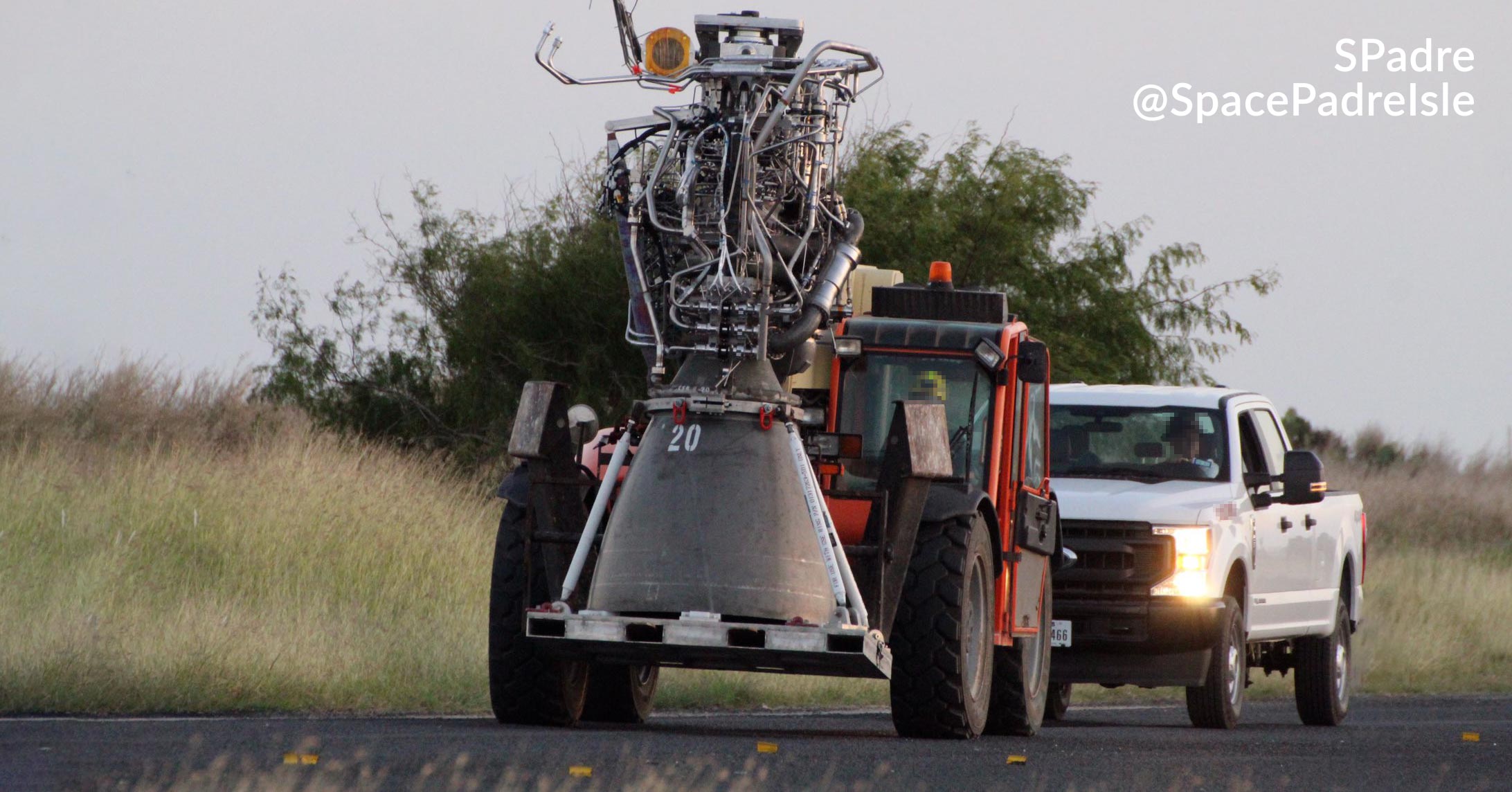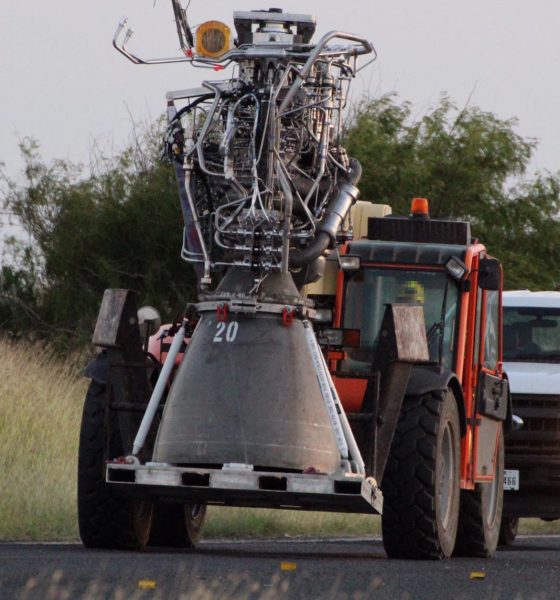

News
SpaceX Starship rocket gets new Raptor engine for Starhopper-style hop test debut
SpaceX has decided to install a different Raptor engine on its fourth full-scale Starship prototype in the buildup to the next-generation rocket’s inaugural flight test.
Starship SN4 recently became the first prototype to pass a cryogenic proof test, followed by two successful Raptor engine static fire tests and an even more successful pressure test on May 9th. Set to occur as early as later this month, that string of successes means that Starship SN4 is now all but guaranteed to become the first prototype to take flight. According to photos and information from CEO Elon Musk and FCC filings, that first hop – regardless of the ship – will be powered by a single off-center Raptor engine and likely follow in the footsteps of Starhopper, targeting a max hop height of 150m (~500 ft).
This time around, though, Starship SN4 will be around twice as tall as Starhopper, making for quite a spectacle regardless of the outcome. Currently, SpaceX has already received FCC authorization for Starship communications and is mainly just waiting on FAA approval for the short hop test – a license to launch that Musk suggested could arrive more than a “few weeks” after April 26th. Before Starship is technically ready for that milestone, however, one more test must be completed.

SpaceX has already successfully performed two static fire tests with a Raptor engine (likely SN18) installed on Starship SN4 on May 5th and 7th but the company has decided to replace that particular engine for unknown reasons. Raptor SN18 was removed from SN4 the morning after its (presumably) successful second static fire test, a move that is believed to have been made to avoid losing an engine in the event that a more ambitious cryogenic pressure test destroyed Starship.
As it turned out, that caution was unnecessary and Starship SN4 passed said pressure test with flying colors, reaching a planned maximum pressure of 7.5 bar (110 psi) – technically enough to qualify the rocket’s structure for (uncrewed) orbital launches.

For whatever reason, though, SpaceX has decided to replace Raptor SN18 with Raptor SN20, another of three engines currently on site at SpaceX’s South Texas rocket build and test facilities. That engine swap means that another Starship/Raptor static fire test is now needed to ensure that the new engine has been installed correctly and that both it and Starship are functioning as intended. As of now, SpaceX has scheduled that third static fire as early as Monday, May 11th, with a test window open from 9am to 9pm CDT (UTC-5).

If that static fire and include wet dress rehearsal (WDR) is successful, Starship will technically be cleared for flight. The only obvious missing piece is an attitude control system (ACS). Starhopper, for example, used cold nitrogen gas thrusters quite literally taken off of flight-proven Falcon boosters. It remains to be seen if SpaceX will take the same approach with Starship SN4 or if a different kind of ACS thruster is already installed on the rocket and hidden in plain sight. For now, it looks like we won’t have to wait long at all to find out.

News
Tesla FSD successfully completes full coast-to-coast drive with zero interventions
Tesla community members celebrated the milestone on X, and the feat earned praise from some of the electric vehicle maker’s executives.

A Tesla owner has successfully completed a full coast-to-coast drive across the United States on Full Self-Driving (FSD) Supervised. The trip was accomplished with zero interventions.
Tesla community members celebrated the milestone on X, and the feat earned praise from some of the electric vehicle maker’s executives.
FSD Coast-to-Coast
The coast-to-coast feat was accomplished by Tesla owner Davis Moss, who drives a stealth gray Model 3 with AI4 hardware. Based on data from the FSD database and a community tracker, the last 10,638.8 miles Moss drove in his Model 3 were completed using FSD 100% of the time. His vehicle is equipped with FSD v14.2.1.25, which was installed 12 days ago.
As per Moss in a celebratory post on X, his Model 3 was able to complete a full coast-to-coast drive across the United States in 2 days and 20 hours. His trip started at the Tesla Diner in Los Angeles, CA, and it ended in Myrtle Beach, SC. Overall, his trip spanned 2,732.4 miles.
“This was accomplished with Tesla FSD V14.2 with absolutely 0 disengagements of any kind even for all parking including at Tesla Superchargers,” Moss stated in his post. He also added in later comments that there were zero close calls during the trip.
Tesla community celebrates
The FSD milestone trip was widely lauded by members of the Tesla community, especially since a coast-to-coast drive with zero interventions has been cited by Elon Musk as a target since October 2016, when Autopilot 2.0 was unveiled. At the time, Musk initially estimated that a coast-to-coast drive across the United States should be possible by the end of 2017. Considering Moss’ feat in his Model 3, it appears that Elon Musk’s estimate was not impossible at all. It was just late.
Musk himself celebrated the milestone on X, and so did Tesla VP of AI Software Ashok Elluswamy, who wrote “World’s first fully autonomous coast-to-coast drive, done with Tesla self-driving v14. Congrats and thank you @DavidMoss!” in a post on X. The official Tesla North America account also celebrated the feat, writing “First Tesla to drive itself from coast to coast w/ FSD Supervised. 0 interventions, all FSD” on X.
Elon Musk
Elon Musk: Tesla Model Y is world’s best-selling car for 3rd year in a row
The Model Y has now established an impressive streak that would otherwise have been impossible before Tesla.

Elon Musk has announced that the Tesla Model Y has become the world’s best-selling car by volume for the third consecutive year, capping 2025 with another dominant performance.
The Model Y has now established an impressive streak that would otherwise have been impossible before Tesla.
Three years in a row
Musk posted on X: “Tesla Model Y is now officially the world’s best-selling car for the third year in a row!” The CEO’s comment echoed an update that Tesla included in its 2025 recap, which highlighted, among other things, the Model Y’s incredible streak.
The Model Y has held the title since 2023, outperforming traditional leaders like the Toyota RAV4 and Corolla thanks to its bang-for-the-buck nature and its stellar combination of practicality, performance, and tech. The Model Y is also lauded as one of the safest vehicles on the road, making it an ideal choice for families in key markets such as China.
An impressive 2025
The Model Y’s sales feat in 2025 is especially impressive considering the introduction of the vehicle’s new variant. Tesla’s changeover to the new Model Y across its global factories resulted in sales being paused for some time in the first quarter. As per Tesla’s Q1 2025 vehicle delivery and production report, “the changeover of Model Y lines across all four of our factories led to the loss of several weeks of production in Q1.”
This suggests that the Model Y’s sales remained strong in 2025 to the point where it could still claim the title of the world’s best-selling vehicle by volume, even with its sales being throttled during the first quarter of the year. It would then be interesting to see just how far the Model Y can go in 2026, especially considering the rollout of new variants like the six-seat extended wheelbase Model Y L, the affordable Model Y Standard, and the top-tier Model Y Performance.
News
Tesla shares epic 2025 recap video, confirms start of Cybercab production
The cinematic montage, posted by the official Tesla account on X, celebrated the company’s progress in EVs, energy, and Robotaxi development.

Tesla has released an epic year-in-review video for 2025, recapping some of its major achievements from refreshed models to autonomy breakthroughs and production ramps.
The cinematic montage, posted by the official Tesla account on X, celebrated the company’s progress in EVs, energy, and Robotaxi development while looking ahead to an even bigger 2026.
Tesla’s 2025 highlights recap
Tesla has had a busy 2025, as highlighted in the recap video. The video opened with Elon Musk explaining the company’s pursuit of sustainable abundance. A number of milestones were then highlighted, such as the rollout of FSD v14, Optimus’ numerous demos, the opening of the Tesla Diner in Hollywood, LA, the completion of the world’s first autonomous car delivery, and the launch of the Robotaxi network in Austin and the San Francisco Bay Area.
Tesla also highlighted several of its accomplishments over the year. As per the company, the Model Y was the year’s best-selling vehicle globally again, and Teslas became more affordable than ever thanks to the Model 3 and Model Y Standard. Other key models were also rolled out, such as the refreshed Model S and X, as well as the new Model Y, the new Model Y Performance, and the six-seat, extended wheelbase Model Y L.
The Megablock was also unveiled during the year, and the Supercharger Network grew by 18%. Over 1 million Powerwalls were also installed during the year, and the Cybertruck became the first EV truck to get both an IIHS Top Safety Pick+ award and an NHTSA 5-Star safety rating.
Cybercab production confirmed
Interestingly enough, Tesla also confirmed in its 2025 recap video that the production of the Cybercab has started. This bodes well for the vehicle, as it could result in the vehicle really being mass-produced in the first half of 2026. Elon Musk confirmed during the 2025 Annual Shareholder Meeting that Cybercab production should earnestly start around April 2026.
Musk has also noted that the Cybercab will be Tesla’s highest-volume vehicle yet, with the company aiming for an annual production rate of about 2 million units. “If you’ve seen the design of the Cybercab line, it doesn’t look like a normal car manufacturing line,” Musk said earlier this year. “It looks like a really high-speed consumer electronics line. In fact, the line will move so fast that actually people can’t even get close to it.”







